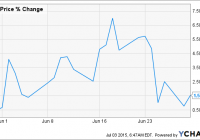Long The S&P 500 But Feeling A Little Uneasy? PUTX May Be Your Answer
Summary Investors in the broad U.S. equity market feeling uneasy or anticipating a correction may buy put options on the S&P 500 for protection. If the timing is right this “insurance” can be valuable. A better way to provide downside protection while also providing upside potential returns is by selling cash collateralized puts on the S&P 500. Investors in the broad U.S. equity market feeling uneasy or anticipating a correction may buy put options on the S&P 500 for protection. If the timing is right this “insurance” can be valuable. However, more often than not, we see the cost of this insurance, buying these puts, reduces returns. A better way to provide downside protection while also providing upside potential returns is by selling cash collateralized puts on the S&P 500. This is exactly the strategy of the recently launched ALPS Enhanced Put Write Strategy ETF (NYSEMKT: PUTX ). PUTX was spearheaded and developed by Rich Investment Solutions, which is a sub-adviser to the new fund. Kevin Rich, founder and CEO of Rich Investment Solutions, came from Deutsche Bank where he created and launched the commodity and currency-based ETFs: the PowerShares DB Commodity Index Tracking Fund (NYSEARCA: DBC ), the PowerShares DB Agriculture Fund (NYSEARCA: DBA ), the PowerShares DB U.S. Dollar Index Bullish Fund (NYSEARCA: UUP ), and the PowerShares DB U.S. Dollar Index Bearish Fund (NYSEARCA: UDN ), among others. In 2013 ALPS and Rich launched the first put writing ETF called the ALPS U.S. Equity High Volatility Put Write Index Fund (NYSEARCA: HVPW ). For many years CBOE has published two benchmark indices on at-the-money monthly put and call writing: the CBOE S&P 500 Put Write Index (PUT), and the CBOE S&P 500 BuyWrite Index (BXM). There have been ETFs in the market tracking BXM for some time but not on PUT. As PUT has shown historically superior returns compared to BXM, there is recent renewed interest and new products coming to market offering investors access via ETFs. With that in mind, we asked Kevin Rich a few questions about their new fund they just launched with ALPS. Dave Fry: Good to talk with you again Rich, can you please tell us a about PUTX? Kevin Rich: Thanks. PUTX is the first broad based put write strategy ETF. PUTX will sell one month at-the-money put options on the S&P 500 every month, or twelve times a year. It’s designed for investors looking for a defensive investment in the in the S&P 500. Selling monthly, at-the-money puts on the S&P 500 has historically generated 18% – 21% option premium per year. While this premium represents close to the maximum upside return of the PUTX strategy, it represents the possible downside protection over the course of a year in a declining market. Dave Fry: Interesting, so is it tracking the CBOE PUT index, which hypothetically sells puts monthly as I understand? Kevin Rich: No, PUTX is not a passive index tracking fund, so it will not replicate the PUT index or strategy. PUTX will look to sell options on a monthly basis not only on the SPX am settled options that the PUT index uses, but PUTX but will also be able to sell options on the SPX pm settled options or on the American style options on the S&P 500® Trust ETF (NYSEARCA: SPY ). PUTX should be able to pick up additional premium over the benchmark index by expanding the underlying options it uses. Dave Fry: Any other differences between PUTX and the CBOE PUT index? Kevin Rich: Yes, PUTX will not simply go long short term U.S. T-bill like the PUT index; rather PUTX will its cash in short duration investment grade fixed income securities. Further, PUTX will have the ability to bring in additional premium intra-month when we see there is an opportunity to roll some strikes up without taking material additional risk for the fund. Dave Fry: Not to harp on the comparison, but do you expect PUTX to track the CBOE PUT index closely? Kevin Rich: Yes, our expectation is we will have a high correlation and beta to the PUT index, but with the strategy differences described earlier we believe PUTX should be able to generate additional returns over the benchmark. Dave Fry: I would expect to have seen the BXM and PUT indices have identical returns over time but PUT has outperformed. Why do you feel selling puts offers and advantage over selling calls? Theoretically they should be the same, but there are 2 main reasons why PUT has outperformed. First, PUT sells ATM or slightly OTM of the money puts, while BXM sells ATM or slightly OTM calls. OTM puts not only provide some additional downside protection to a declining market (OTM calls by definition do not), they also tend to be priced more richly than OTM calls providing more premium. Second, PUT collateralizes its short put position by investing in TBills, while BXM covers its short call positions by investing in the S&P 500. As a result, PUT performance benefits from interest income while BXM only benefits from dividend income. Dave Fry: I know you have just launched, but who do you expect to use PUTX and where might it fit in a portfolio? Kevin Rich: Initially we would expect RIAs, funds and institutions familiar with the mechanics and benefits of broad based put writing strategies to adopt PUTX. Really any holder of the S&P 500 should consider diversifying into PUTX because of its defensive potential. Others may hold PUTX in their liquid alternative bucket. Advisers in the larger wire house firms will recognize the potential for PUTX to diversify and add returns over their existing buy write investments, so we expect pick up form these firms; some initially, and others over time. Dave Fry is founder and publisher of ETF Digest and has been covering U.S. and global ETFs since 2001. ETF Digest was named one of the most informative ETF websites in the 10th Annual Global ETF Awards. Disclosure: I/we have no positions in any stocks mentioned, and no plans to initiate any positions within the next 72 hours. (More…) I wrote this article myself, and it expresses my own opinions. I am not receiving compensation for it. I have no business relationship with any company whose stock is mentioned in this article.

